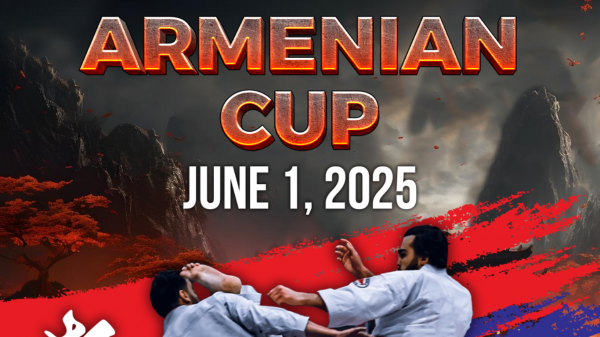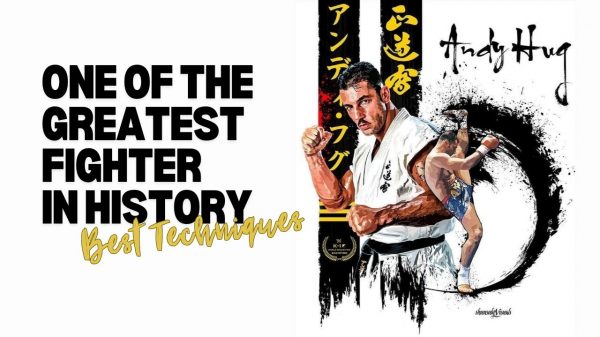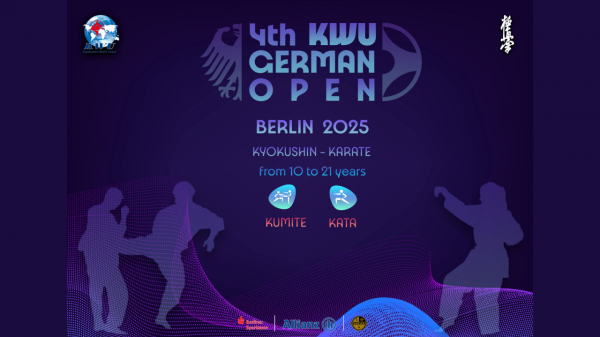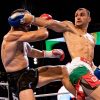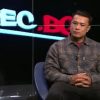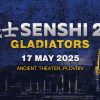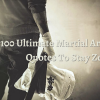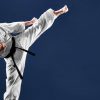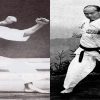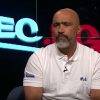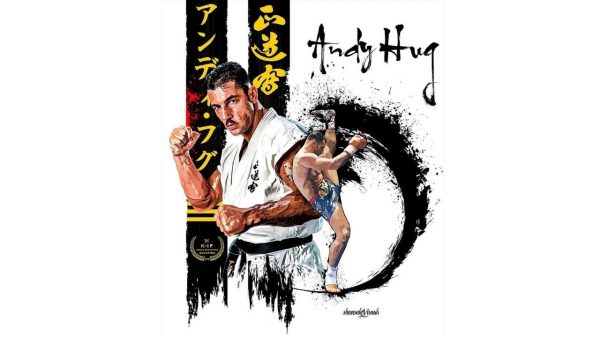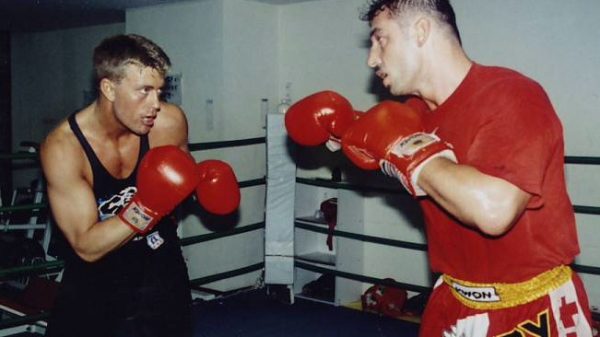Mas Oyama in America – part 1 of 3
By Graham Noble: This article, or historical essay, is part of the book I am trying to write on the history of karate and its masters. This is one section of the chapter on Mas Oyama, his Kyokushinkai style, and his influence on karate history. It’s about his 1952 tour of the USA and it relies heavily on translations from Japanese material: I have to thank Mitchell Ninomiya for his translation of the old “Ooru Yamimono” article, and especially Brian Sekiya, who translated all of the other Japanese material. There wouldn’t really have been a finished piece without Brian’s input. Thanks also to Joe Lopez for his reminiscence of Mas Oyama in New York, to the OldTime Strongman site for the rare old newspaper reference Sebastian Miller , “The Rock Breaker”, and to Charles Goodin for putting this long article on his site, in full.
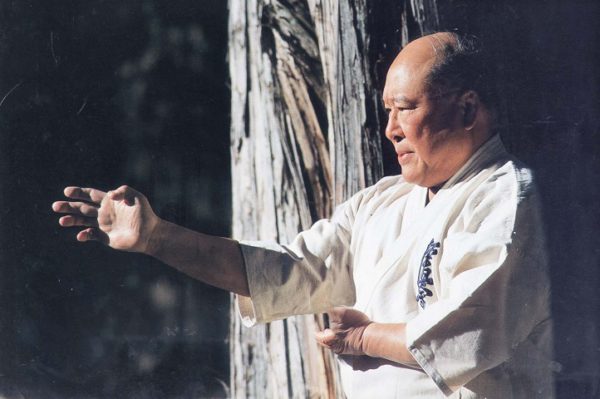
1. Mas Togo
In April 1952 Mas Oyama and Kokichi Endo flew in to Chicago to begin a tour of the American pro-wrestling circuit, and this is really the start of Oyama’s legend as an undefeated fighter who travelled the world facing numerous challengers to test the power of his karate. One account, recycled numerous times on the internet, states that on this American visit he fought and defeated 270 challengers, including boxers and wrestlers; that none of his opponents lasted more than three minutes, and that most of the fights were won by one punch, in just a few seconds.
The circumstances behind the tour are a little obscure. Endo had been a high ranking judoka but had followed the famous Masahiko Kimura into a professional-wrestling career, so from his point of view it was a straightforward pro-wrestling deal. Apparently the well known American wrestler “The Great Togo” wanted to bring Japanese wrestlers to the United States and the name of Endo, who had trained with Rikidozan, Japan’s top pro-wrestler, came up. Mas Oyama’s name also came into the frame somehow, and although he wasn’t a wrestler he was known as a tough guy and an expert in karate. According to Endo, Togo thought that “if he could combine our talents, me and Oyama-kun, he could do good business”, and Endo was clear too that Mas Oyama “only went to America to do his karate demonstrations”,and not to wrestle. Oyama himself said that he was chosen on the personal recommendation of the well known judo teacher Tatsukuma Ushijima. In “What is Karate?” (1958) he wrote that the trip had been organised by the Chicago Pro-Wrestling Association and twenty five years or so after the tour he told “Fighting Arts” magazine that he had been offered $100 dollars a week plus expenses for the trip and in a Japan that was still suffering from the after effects of the Second World war that was a lot of money. “I didn’t want to go really”, he said, “because to me money for budo just didn’t seem right, but I had to live”. And after years of hard training he was in top physical shape too. “Boy, was I strong then!” he recalled.
In America Endo and Oyama were teamed up with “The Great Togo”, who was actually Gerald Okamura, a Nisei Japanese. The Great Togo was one of the top heels in wrestling, and Endo and Oyama were to appear as his two brothers, “Ko Togo”, and “Mas Togo”.
[bctt tweet=”Because to me money for budo just didn’t seem right, but I had to live” username=”kwunion”]
The September 1952 edition of “Ring” magazine included a one page feature on The Great Togo and his two brothers, and it is typical pro-wrestling hype.
“The family with the built in hammers — That’s the Togos. Kazuo Togo, known to his mat followers as The Great Togo, and brothers Mas and Ko, both of whom have recently come over from Japan.
“All are adept with their hands. The Great One needs no introduction — His chop blows have spoken for themselves, but brothers Mas and Ko are new attractions to the mat sport.
“There exists in Japan a singular contact sport known as karatae at which Mas Togo excels. According to is brother Kazuo, Mas went through the normal training period of all Nipponese who go out for a life in karatae.
“The training begins at an early period, in Mas’s case at the age of 14. First the would be karate expert breaks his hand . . . Gentle sport! . . . But it gets better as we check further. The next step is to develop callous skin between the first and second knuckles.
“. . . Having developed the hump of distinction between the digits, he is taught the knack of breaking boards, bricks or anything else lying around that needs adjusting. In the competitive field of karatae many things get adjusted and broken. In fact there are 14 weak points in the human anatomy, one of which is the collarbone. The karatae makes good use of this information. By breaking a collarbone, the victim loses the use of his arms and without his arms his karatae ability is materially lessened.
“The eyes have a habit of popping out of their orbits when the proper spot on the temple is popped . . . Also the lower ribs break easily when one knows how . . . Mas Togo learned all this and more . . .No wonder no one wants to wrestle with him in the U.S.
“. . . One of Mas’s sitting up exercises is to slug his hands with a sledge hammer or other weighty object in order to strengthen his hands.
“The one man wrecking crew served as a special body guard to General McArthur when the home island was first occupied.
“How much training goes into making a karataeman? In the case of Mas it took 14 years. He’s now 28. For three years of that time he spent his life at a temple during which time he was allowed no contact with the outside world. Not even his family was permitted to see him. The course is demanding on the mind as well as the body . . . He was never sure at what moment he might meet someone who could make his eyes pop out.
“Many fall by the wayside in this exacting sport. To do so means a loss of face and to the Nipponese failure, loss of face and disgrace are all rolled into one package. Mas made the grade and should be an interesting addition to American wrestling”.
Mas Oyama was also the subject of a three page feature in the June 1952 edition of “Scene” magazine, in which he was referred to as “Thunderbolt Togo . . . a terrifying exponent of karate — perhaps the deadliest form of weaponless self defense devised by man . . . It cannot be put to full use without maiming or killing. To demonstrate its lethal characteristics against humans is unthinkable.
“The deadliness, nevertheless, is demonstrable. Togo can – and has — killed steers by cracking their skulls with one blow of the fist. He also has ripped out the entrails of dogs with a single slashing stroke of his finger tips . . . The young (28) expert in controlled mayhem is only 5 feet 8 inches tall and weighs, at the most, 180 pounds. He modestly believes that he can handily dispose of ‘maybe 15 or 16’ adversaries in an ordinary free for all.
“‘There are 44 areas of the body that are vital targets’, he says. ‘If I hit a man in any one of those parts he will be crippled, paralyzed or killed.'” The article reported how Oyama allowed a trainer with a two pound hammer to pound his knuckles, “not with all his might, but by no means gently”, and how he said “Harder. You’re only tickling me”. He was described as training every day, doing 300 uninterrupted pushups, rope skipping for forty continuous minutes, doing road work and shadow boxing, and standing on his head for five minutes to strengthen his neck muscles.
After arriving in Los Angeles the Togo brothers travelled almost straightaway to Chicago where Oyama gave his first demonstration at a wrestling show. It was a big crowd and he was a little apprehensive. He began his demonstration with kata, Sanchin first and then Tekki, but the audience soon grew restless and some people began to boo, shouting for the demonstration to be stopped. “I felt dejected, and yet vexed and provoked.“, he remembered. The demonstration moved onto breaking although here he was concerned about the strength of American bricks. He took a brick, but his first shuto strike failed to break it, as did the second. On the third attempt the brick broke in two and the audience was impressed. “As they admired and cheered I gained confidence in myself. I then broke a pile of six pieces of one inch board with seiken, and crushed a stone without difficulty. It seems that these Americans who had seen such a powerful demonstration of karate for the first time were at last giving admiring recognition to this martial art. Thus my first performance proved successful.”
Oyama wrote that his tour with Endo and Togo took them through thirty two states including Iowa, Ohio, Minnesota, North Dakota, South Dakota, Massachusetts, New York, Michigan, Virginia, North Carolina and South Carolina, with Chicago as the centre of operations. They also appeared in Canada.
In later years, as the Mas Oyama legend grew, this 1952 trip came to be seen as a triumphant tour of America, in which he introduced karate to the West and defeated numerous challenges to prove the power of his technique. In fact it seems to have been an isolated fling with the garish world of pro-wrestling and there is little trace of it all beyond a few scattered magazine and newspaper clippings. In response to my query about all this Robert W. Smith told me that “Oyama’s triumphal tour of the U.S., as far as I was ever able to find out, never happened. And if it had happened, I would have known at the time”. Bob Smith was using little bit of poetic licence there in a letter, as in fact he had sent me a couple of Mas Oyama clippings from that tour; but it was the later exaggeration that he had a problem with. Years later, in his “Martial Musings”, he wrote “I never found one challenger or even one reliable press report”.
[bctt tweet=”I never found one challenger or even one reliable press report” username=”kwunion”]
Oyama himself, in the early editions of “What is Karate?” wrote that “in a ten month tour we engaged in three matches with pro-wrestlers, gave karate exhibitions thirty times, appeared over television nine times, and had $1,000 dollar prize matches three times”. The reference to the three matches with pro-wrestlers is puzzling: maybe they were the usual worked matches, we don’t know. And the ten months is a little problematical too. Newspaper clippings from July 1952 imply that Oyama was in the USA and Hawaii for four months, and Koichi Endo thought it might have been eight months or so. Then there is a photo of Oyama and his supporters which is said to have been taken on his arrival back in Japan in September 1952, which gives you six months. The whole tour suffers from a lack of documentation.
Three challenge matches quoted by Oyama sounds reasonable, but the exaggeration started very early. In 1953, only months after he had returned to Japan, “Argosy” magazine asked “Is there any defense against karate by an untutored person? If the experience of one karate expert, Oyama, who toured the United States several years ago (sic), is any proof, the answer is no. The small but compact man left more than a hundred of America’s burlier, rougher citizens flat on their backs. One policeman who claimed to be a third ranked judo fighter was carried from the ring with seven broken ribs 90 seconds after the opening buzzer. Fighting a karate expert is for another karate expert only”
The later figure of 270 undefeated challenge matches by way of 270 quick knockouts . . . Presumably this came from the inside cover of Oyama’s “Kyokushin Way” (1979) which states that in his 1952 tour of the U.S. he gave “270 exhibition matches”, which in a nine or ten months tour works out at about one a day. It’s unclear what an exhibition match might be, but somehow this statement became converted into 270 full contact no rules fights to the finish. A figure of 270 though is simply not credible, even in the logistics of arranging such a number of appearances and fitting them into that number of wrestling shows in different towns and cities. And interestingly, the text on that same inside cover goes on to say, just a few lines later, that “He was challenged by two American professional boxers and one professional wrestler and beat them all,” so we are back to three challenge matches again.
In any case the figure of 270 knockouts in 270 fights compares with the all time record of knockouts by a professional boxer, which is held by Archie Moore, who accumulated 145 ko’s over a career which spanned four decades, (1935 to 1963). Sugar Ray Robinson, many people’s pick as the best boxer of all time pound for pound, had 109 ko’s in 209 fights over twenty five years. Even Rocky Marciano, the world heavyweight champion of the early 1950’s, could only reached a knock out percentage of 88%, with 43 ko’s in his 49 fight unbeaten career.
Of course, it could be argued that this was professional boxing where you were facing other professionals, where careers had to be managed over time, and where match-ups had to be arranged and bills put together. But in fact there is a kind of direct comparison with Oyama’s story seventy years before in John L. Sullivan’s great “knocking out” tour throughout America in 1883/84. Sullivan was the first real knock-out artist in boxing and a year after he won the heavyweight title in 1882 he went on an eight month tour throughout the States, giving boxing exhibitions and offering large sums of money to anyone he couldn’t stop in four rounds under Queensberry rules: $250 initially, and eventually $1,000, a sensational amount for those days. In his 1892 autobiography “Reminiscences of a Nineteenth Century Gladiator“, Sullivan wrote that he had knocked out 59 challengers on that tour. An article in “The Police Gazette” of 1905 by one of the members of the touring group gave the number as 39. Frank Moran said it was 36. Michael T Isenberg, in his authoritative “John L’ Sullivan and his Times” tracked The Great John L. through the newspapers of the day and put the number at 11. Adam J. Pollack, in his own excellent book on Sullivan’s boxing career, also gave a detailed account of the tour from local and regional newspapers and identified 12 knock out victims. And the fact that Sullivan’s tour could be traced in detail through the newspapers, and that those papers gave accounts of his challenge matches, demonstrates that it was a genuine national event. So if Mas Oyama had actually knocked out 270 challengers, including, in his own words, “very famous champions”, then he would have been the sensation of the age – but in fact there is hardly any evidence of his tour having taken place beyond a few scattered newspaper and magazine clippings, maybe less than half a dozen, and not one of these contains a ringside account of an Oyama challenge match . . . . Not one.
When, in “What is Karate?” Oyama mentioned having three challenge matches, he gave no details, but accounts could be found elsewhere, for example, in Jay Gluck’s article “Masters of the Bare Handed Kill” which appeared in the March 1957 edition of “True” magazine. This was an influential article as it was later recycled for Gluck’s popular 1962 book “Zen Combat”, which formed the source material for many later writers.
2. The Challenges
According to Jay Gluck the challenge idea came from Dick Real, “a 6 feet 7 inches pro-grappling champ”, who was offering $1,000 to anyone who could down him. It was in Minneapolis that Oyama accepted the challenge. Real was a difficult opponent and hard to reach, but Oyama feinted with an eye jab, grabbed Real’s hands to pull him in close, and then hit him with three forefist thrusts to the body. “Real went down glassy eyed” after three minutes of fighting.
In Des Moines $1,000 was offered to anyone who could break a brick. A local police officer, who said he was a third dan in judo, tried but his hands started to sweat and even though he hit it till his hands bled he failed to break the brick. When Oyama broke it with one strike the policeman began calling him a fake and challenged him to fight, and Oyama said ok. The officer threw wild roundhouse punches which Oyama evaded before countering with a series of blows to the body which sent the man down with seven broken ribs. The crowd went mad and Oyama had to be escorted out of the building by “a police riot squad”.
[bctt tweet=”2. The Challenges #kyokushin #MasOyama” username=”kwunion”]
In Chicago Oyama fought Dan Calendar, a tough 250 pound ex wrestler and boxing and judo coach to the police training school. Calendar threw a right hook, Oyama blocked it with his left hand and then leaped in to deliver two knife hand chops with the same hand to Calendar’s neck and temple. “Dan went down, his left hand still cocked to protect him from the right that never came. He was out cold for two hours after only ten seconds in the ring”.
After that there was Becker, a lightweight or middleweight boxer who gave Oyama a lot of trouble with his speed and manoeuverability.. At one point Oyama went out of the ring after missing a punch, but he got back in and eventually took Becker out with a spear hand thrust to the solar plexus. “Becker collapsed, seconds before the bell”.
Of course, Jay Gluck hadn’t seen any of these matches so he may have got the stories direct from Mas Oyama himself, although one possibility is that the source was a 1955 series of articles by Oyama, Shuto Ju Nen”, (Shuto Ten Years) in the newspaper “Toto Shinbun”. These articles were reprinted in “Kakuto K” magazine in its June 2000 and following issues. Here the matches with Dick Real, the wild Des Moines policeman, and George Becker, were described in detail.
In part 3 of the series of articles Oyama wrote that he was challenged to a $1,000 “shinken shobu” or death match by the 260 pound pro-wrestler Dick Real in Minneapolis. Three minutes into the fight Oyama was able to get in close and jab Real in the eyes. Real covered up and Oyama feinted with his right knee and then launched three forefist blows in to Real’s torso. The big pro-wrestler went down.
The fight with George Becker, a pro wrestler about the same size as Oyama, took place in Charlotte, North Carolina. Oyama described Becker as a handsome man with a lot of female fans who kept yelling at him to “Beat him to death!” and ” Choke him out!” Almost immediately after the match started Becker connected with a punch to the jaw which knocked Oyama out of the ring. Becker just stood and looked down at him but then Oyama noticed a slight loss of concentration and he jumped back into the ring and punched Becker in the back. The two men then got into a clinch and both men went out of the ring. “The audience was going wild. It was no longer just a match, it had turned into a death struggle” The fight continued outside the ring until Oyama dropped Becker with a punch to the body. At that moment he felt a tremendous pain on his back. He instinctively turned and defended against the attack and realised that a woman, who he had now knocked to the floor, had attacked him with a folding chair. The crowd became incensed that he had knocked down a woman and wanted to attack him, but there was a strong police presence and trouble was avoided.
The story about the police officer in Des Moines who failed to break a brick — or tiles in this version – and then challenged Oyama is told in detail in the series of articles. After failing with the breaking, the officer said “I did not break the tiles, but I can beat you in wrestling.” The article then goes on, (Togo is spelt Tojo throughout the text) : –
“OK. I will do it.” I immediately accepted his challenge. “You’ve got guts”, he smiled and said. “I have to make sure that you have $1000 prize money on the match. Are you sure you’ll give me $1000 if I beat you?” I nodded. He said, “OK. That’s a promise.”
That man was well-known as a strong tough man in his town. Because of that reputation, he could not back down from the challenge, or he would lose face in front of his hometown people. His body was trembling with the excitement and his face showed his determination to beat me to death. The audiences were expressing their excitement in anticipation of the match.
“Go for it! Beat down Mas Tojo!” I heard such screams throughout the arena, then I heard the opening bell. The match began.
The man quickly began throwing his powerful punches. He rushed onto me with his powerful body. The whole audience was like a fire, burning for revenge. I thought, “This fight is not like anything else – He intends to kill me. Either he kills me or I kill him. It is kill or be killed” I made a decision in my mind that I had no choice but to beat him almost to death.
As soon as my mind was made up, I leaned forward, ducking the devastating blows thrown by his enormous arms. Then, almost out of desperation, I unleashed and connected my chudan-zuki; once, twice and three times. Each time my tsuki was connected, I heard the dull un-describable sounds. Seven of his ribs were broken as a result of my chudan-zuki. >He went down for the count with a KO. I won the match in a mere minute and a half. The match was over, but not the crowd. The whole crowd got up on their feet, and began throwing apples and empty bottles like a rain falling on us. They all screamed, “Don’t let Tojo get away. Kill Tojo!” Their screaming of my name all of a sudden became “Tojo!”, “Kill Tojo!” The audience was over-excited. They started rushing toward the ring. I knew there was no way out.
The police, with guns and sticks, began surrounding the ring, trying to protect us. Up to this point, Endo 6-dan was merely my assistant and a helper, but now he came close to me and tried to protect me as well. However, there were just too many people for us to deal with. Making things even worse, the crowd was getting wilder.
I gave up. Or, I better say I had to give up. The crowd turned into a mob screaming out something and moving toward the ring. Even if the policemen, who were surrounding the ring, tried to intimidate the crowd with their guns and sticks, what could that accomplish? It was like going against the raging stream. We were going to be pushed and thrown down by the mob and punished. It was like a death sentence. It was getting close to the unimaginable reality. “There’s no way out, Endo-kun” I said to Endo 6-dan. However, I was remarkably calm, much to my surprise. “Well, there’s no use panicking and trying to get out of this. Like a real man, I will face the crowd.”
Endo-6 dan looked at my face ever so slightly, and stared at the crowd. Death wouldn’t just come to me alone. The angry crowd would definitely harm Endo and kill him as well. I was overwhelmed with the feeling of guilt toward Endo. He got into this because of me.
“There must be a way out, Oyama-kun” Endo-6 dan kept staring at the mob and said it bluntly. He was willing to fight them, fight the angry mob. “OK. I will fight!”. My mind was made up to fight. Just as Endo said, “If they attack us, we must fight back”
None of this was our fault. I had hurt my opponent by breaking his ribs but he was in the fight with the intention of killing me. It was self defense on my part. If I hadn’t defended myself, and had not fought back, I could have been killed by him.
“There’s absolutely no reason that we deserved to be punished and be killed.”
I stood with Endo shoulder to shoulder. We were ready to fight the mob. “No matter who comes toward us, if they step onto the ring, I will use my long-years-trained shuto, and beat them to death!”
“Kill Tojo!” — “Don’t let him get away alive!”
The crowds were screaming, pushing and shoving at the ring side. The police were overwhelmed. They were still trying to stop the mob. At that brief moment, I heard a very loud siren. It was a sound of an ambulance. Two ambulances arrived. They had come to take my opponent to the hospital. Then, I heard the siren again from the second ambulance. Only one person was hurt, that was my opponent. There were no other injured people here. Endo and I looked at each other and we thought this was a little strange.
[bctt tweet=”Kill Tojo! Don’t let him get away alive!” username=”kwunion”]
I wondered whether one of the ambulances was for me after I was killed. “This is America. They are quick to respond.” I realized later that it was my overreaction to the situation. The second ambulance was there for my rescue. The police who were carrying the stretcher came into the arena, followed by many policemen wearing protective equipment. They fought their way against the angry mob to the ring. The sight of the policemen with equipment appeared to scare the crowd somewhat. The police came up to the ring, surrounded us to protect from the crowd and said, “Step out of the ring. Then leave the arena.” We had no idea where we were going afterwards, but we stepped out of the ring.
Several policemen, with their guns in their hands, were leading us for our escape, breaking up the crowd. With the protection by the police, Endo and I followed them. The whole audience booed and screamed. The shouting voices were showering over us. But, none of them physically touched us after all. I finally got outside of the arena and got on the ambulance. Endo said, almost in a murmur like voice, “Where are they taking us?” “No idea. But we caused the riot. I don’t believe they will let us go free. Most likely, we will be interrogated and put in jail. Well, everything is an experience. I can think of it as a little time off.” However, my expectation was wrong again. The ambulance took us, not to the police station, but in front of our hotel. Noticing the sceptical look on our faces, one of the policemen said, “Please, get off the ambulance and go into the hotel. Then, relax and rest well. You need some rest. (laugh)”. Even before their laughter ended, the ambulance drove off.
Endo and I went back to our hotel room.
“It was a close call.” “We got lucky getting away before their lynching started. It was simply horrible.”
As we were exchanging words like these and we were on the bed, we heard the screaming from downstairs through the window. I heard, “Kill Tojo!” The crowd from the arena had now come to our hotel. On top of that, there were even curious onlookers who had joined them.
“Endo, they came again.” “They never give up. They won’t be satisfied until they kill both of us.”
I thought this time we had no way out. I had thought the trouble was over, but I was wrong. There were more people now than the original crowd at the arena. Some were carrying hunting rifles.
We were resigned to our fate. “No use trying to escape. It’s impossible to get away this time.”
We had to face reality. There was no escape for us. I decided, just as I was in the ring, to meet the mob head on, and to fight to the death.
“Oyama-kun, they came!” said Endo. There was a sound of busy footsteps in the hallway. The mob had arrived. This was our final chapter. Endo and I took our fighting stances in our room. We were ready to fight. Then, several policemen rushed into our room, as if they had kicked through the door. They said, “Get out now, quick! Go to the back door. There is a car waiting for you there. Get in the car and get out of the state.” Although the ambulance left after we were dropped off at the hotel, the police arranged a get-away car parked in the back. “Thank you.” We said it together, and jumped into the hallway. Then, we ran to the back. As the policeman said, there was a car parked there. But there was nobody in the driver seat. I got in, then Endo. Then we heard loud voices. The mob went around the back. I immediately drove off. I heard the sound of a gun firing as we drove away. Then there was more gun fire. Luckily, no bullets hit our car.
I sped through the city, to outside the state. As we were driving through the streets, we saw the lights in the city as though they were totally unaware of this incident. Now, the mob was no longer in our sight. I had managed to escape from the lynch.mob.
Endo said with a smile, “It was really close”. “But” I continued,” it was terrifying racial prejudice. Their resentment against non-whites was simply astonishing. No non-whites should beat whites. There is no reasoning with them, it was just pure hate. But we can’t give up. No matter what they think, if they are tougher and stronger, non-whites can always beat whites”.
Copyright © Graham Noble. All rights reserved.
Part 2 and 2 next two Mondays


